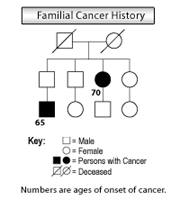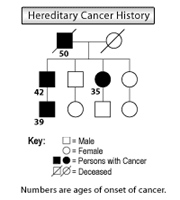When a health care provider looks at a family’s medical history to determine whether the cancer in a family is hereditary, he or she starts by asking questions such as those below.
- How many family members have cancer?
- What type or types of cancer are present in the family?
- Is there someone who has more than one type of cancer?
- What are the ages of onset of cancer?
- What is the sex of the individuals with cancer?
- Are the cancers unilateral (i.e., occurring on one side of the body) or bilateral (i.e., occurring in both kidneys)?
- What type of environmental exposures or lifestyle factors do the individuals with cancer have that might have influenced their risk of cancer (i.e., are they smokers)?
- How are the individuals with cancer related to one another?
- Is there a vertical pattern of inheritance observed (i.e., parents with cancer who have children with cancer)?
- What is the ancestry and ethnicity of the family?
All of this information is recorded in the form of a family tree, called a pedigree. The information is used to try to classify the family history into one of three categories described below. Often, additional information such as medical records or results of genetic testing may be gathered to aid in the classification process. Classifying the family history helps in determining whether relatives have an increased chance of developing specific types of cancer, how great the risk of cancer might be and whether genetic testing might be helpful in further evaluating cancer risks in the family.
What is sporadic cancer?
The word sporadic means “to occur by chance.” Families who have a single person with cancer at an older age are usually classified as “sporadic.” In other words, there is not an inherited pattern of cancer present, and often only one or two individuals in the family have cancer at a typical age of onset. Relatives are usually not at increased risk of developing cancer. Genetic testing is usually not beneficial in these families.
What is familial cancer?
When there are more cases of cancer in a family than chance alone would predict, but the features of hereditary cancer (described below) are not present, a family is said to have “familial cancer.” In other words, in these cases, there is a cluster of cancers in the family, but no clear pattern of inheritance, and the cancers occur at the average age of onset. Familial cancers may be due to a combination of genes and shared lifestyle factors or environmental exposures (e.g., multi-factorial inheritance). On the other hand, some of these histories can represent a chance occurrence of sporadic cancers. A familial history may also arise due to a single gene mutation (e.g., hereditary cancer) that has reduced penetrance (i.e., a mutation associated with lower cancer risks and later onset of cancer). In general, with familial cancer, close relatives have a modestly increased risk of developing the cancer in question. The chance that genetic testing will be beneficial in further assessing cancer risks is usually small.
What is inherited cancer?
These families have multiple family members with the same or related cancers. The cancers tend to occur at younger than average ages (usually younger than 50 years). Also, there is often a history of persons who developed two or more separate cancers; e.g., colon cancer in a breast cancer survivor, bilateral cancers (bilateral breast cancer) or multi-focal cancers (two or more cancers in the same organ such as two separate colon cancers). Families with inherited cancer often have cancer in two or more generations with cancer displaying an autosomal dominant pattern of inheritance. In other words, when a parent has inherited predisposition to cancer, each child has a 50/50 (one in two) chance of inheriting the predisposition. Those in the family that inherit the predisposition have a high chance of developing the associated cancers. Those who do not inherit the predisposition are not at increased cancer risk. Genetic testing can often be beneficial in determining who in the family has an increased cancer risk. In most cases, it is important to test a relative with cancer first, to see if a causative mutation can be identified before testing relatives who have not had cancer.
Some examples of inherited cancer include hereditary breast ovarian cancer sydrome, colorectal cancer, ovarian cancer, prostate cancer and Von Hippel-Lindau syndrome, among others. More information about each of these examples is available from the links at left.



